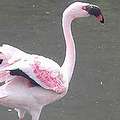 坦尚尼亞與肯亞交界正規劃開設一個蘇打粉工廠,恐將威脅整個東非小紅鶴(lesser flamingos)族群的存活,保育團體為此感到十分激憤。這種每年暑假成千上百群聚在湖邊繁殖的淺粉紅色鳥類,吸引全球遊客前來觀賞。
坦尚尼亞與肯亞交界正規劃開設一個蘇打粉工廠,恐將威脅整個東非小紅鶴(lesser flamingos)族群的存活,保育團體為此感到十分激憤。這種每年暑假成千上百群聚在湖邊繁殖的淺粉紅色鳥類,吸引全球遊客前來觀賞。
泡鹼湖資源公司(Lake Natron Resources)將負責興建這個工廠。這家公司是一個規模很大的印度集團「塔塔化學公司」(Tata Chemicals)的子公司,他們預計每年將開採50萬噸的蘇打鹼粉(碳酸鈉)。蘇打粉可用來生產玻璃、化妝品、清潔劑、紙漿、及其他工業產品。
位於東非大裂谷(the Great Rift Valley)的泡鹼湖是很有名的鹼水湖,湖水含有濃度很高的碳酸鈉。這個湖吸引全世界75%紅鶴鳥種前來繁殖,是全球5大繁殖地中聚集數量最多的一處。保育人士表示,如果這個繁殖地被毀損了,目前還沒有資料顯示這種鳥能在其他種環境繁殖成功。
這個湖是小紅鶴(Phoenicopterus minor)過去45年來唯一的繁殖地,是拉姆薩溼地公約列舉的國際重要溼地(Ramsar Wetland)之一,也是國際鳥盟(BirdLife International)所認定的重要鳥類棲地。
一份對這個計畫進行的環境影響評估報告初稿,在7月12日於坦尚尼亞達累斯薩拉姆區所舉行的研習營中發表。報告中指出,計畫興建的工廠,將會把每年在那裡繁殖的50萬隻小紅鶴暴露在極端危險的環境中。
 保育人士擔心蘇打粉工廠會對這個湖泊脆弱的自然生態造成干擾。由於小紅鶴是世界自然保育聯盟(IUCN)列為瀕臨威脅的物種,即使是棲地微小的改變,都會擾亂它們的繁殖活動。
保育人士擔心蘇打粉工廠會對這個湖泊脆弱的自然生態造成干擾。由於小紅鶴是世界自然保育聯盟(IUCN)列為瀕臨威脅的物種,即使是棲地微小的改變,都會擾亂它們的繁殖活動。
非洲保育中心奈洛比基地的生態學家模瓦堤(Ken Mwathe)表示,這個環境影響評估證實了環保人士過去數個月來提出的警告內容。也就是,設立這個工廠將會使泡鹼湖的溼地狀態改變,對溼地引入大量的光線及噪音污染。報告中還指出,抽取蘇打鹼粉也會對湖水的化學組成造成極大的衝擊。
Conservation groups are outraged over a proposed soda ash factory near Tanzania's border with Kenya that threatens the survival of the entire East African population of lesser flamingos. The light pink birds that flock by the hundreds of thousands to the lake each summer to breed attract visitors from around the world.
The plant would be constructed by Lake Natron Resources, a subsidiary of the giant Indian conglomerate Tata Chemicals, to mine 500,000 tons of soda ash, or sodium carbonate, each year. Soda ash is used to produce glass, cosmetics, detergent, paper pulp and other industrial goods.
Lake Natron, in the Great Rift Valley, is known as a soda lake because of its high concentration of sodium carbonate. It is attracts largest number of flamingoes of of the world's five breeding sites - 75 percent of the species. If it is damaged, conservationists say there is no evidence that the birds will breed successfully elsewhere.
The only East African site in which lesser flamingo, Phoenicopterus minor, has bred in the past 45 years, Lake Natron is recognized as a Ramsar Wetland of International Importance, and as an Important Bird Area by BirdLife International.
A draft environmental impact assessment of the project, released July 12 at a workshop in in Dar es Salaam, Tanzania, says the proposed factory would pose a significant degree of environmental risk to the 500,000 lesser flamingos that breed there each year.
Conservationists fear the soda ash plant could upset the delicate natural ecology of the lake. Even minute changes in habitat can disrupt breeding by lesser flamingos, which IUCN-World Conservation Union has classed as a near-threatened species.
An ecologist with the Nairobi-based African Conservation Center, Ken Mwathe, says the environment impact assessment confirms what environmentalists have been warning for months. The report acknowledges that building the plant could result in Lake Natron losing its wetland status and create high levels of light and noise pollution. It says that extracting soda ash would have a significant impact on the chemical composition of the water.
全文及圖片詳見ENS






